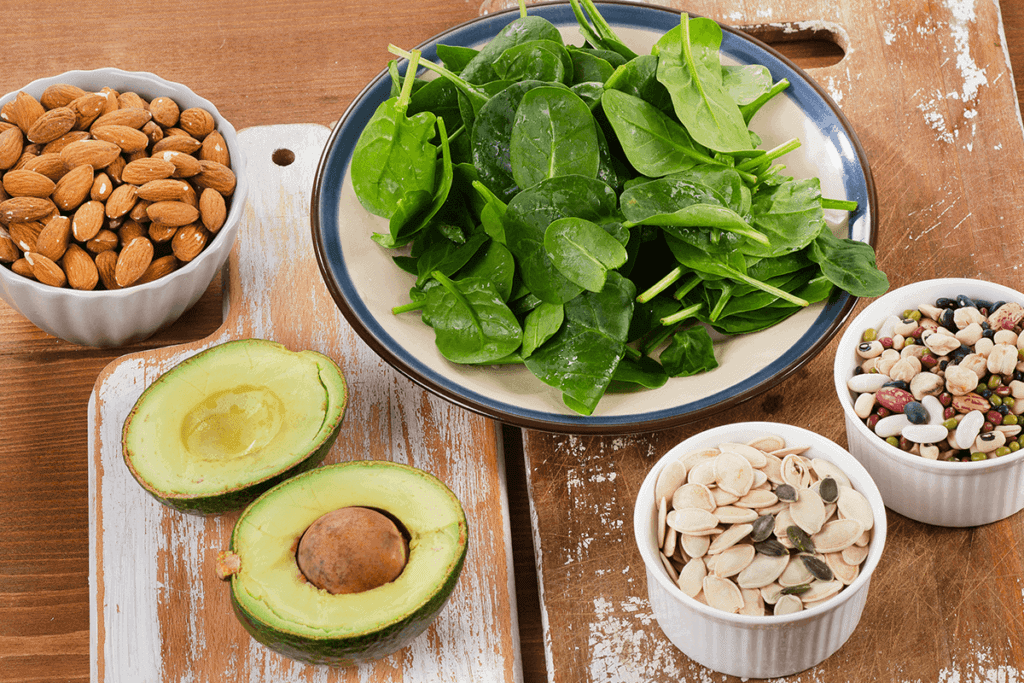
What causes bone loss: diet and bone health
Several dietary factors may impair bone health. One review investigated the effect of dietary patterns on bone strength and resilience, including its effect on bone mineral status, fracture risk, osteoporosis, and bone biomarkers (measurable indicators of disease). The researchers found that a poor quality Western-style dietary pattern and certain unhealthy dietary components were associated with poor bone health. (7) You can reduce bone loss risk factors in your diet, by avoiding:
- Fried foods
- Meat, particularly processed meat products
- Processed foods
- Refined grains
- Soft drinks
- Sweets and desserts (7)
Further, specific nutrient deficiencies may be associated with an increased risk of bone diseases, reduced growth of bone mass in children and adolescents, as well as increased bone loss in the elderly, including:
The best diet for bone health
Consuming a nutritious diet may support bone health in various ways, such as improving bone density and bone mineral content, reducing the risk of fractures, and decreasing bone resorption. (7) The best foods for bone health include:
- Fish and seafood
- Fruit
- Legumes
- Low-fat dairy products
- Nuts and seeds
- Olive oil
- Poultry
- Vegetables
- Whole grains (7)
Adhering to an overall healthy dietary pattern, such as the Mediterranean diet, may protect your bone health. (7) There has been some concern linking higher protein consumption with increased calcium excretion from the body. However, a systematic review concluded that higher protein intake isn’t associated with adverse effects on bone health and may, in fact, support bone mineral density and help protect the spine. (19)
Which nutrients help build strong bones?
We outline five of the key nutrients for bone health below. If you’re a patient, speak with your integrative healthcare practitioner to determine which diet and supplements are best for your individual needs.

Calcium
An essential mineral (cannot be produced by the body) and the most abundant mineral in the body, calcium is a key structural component of bones and teeth. (6)(11) Calcium is naturally found in high amounts in dairy products, canned fish such as sardines and salmon, chia seeds, and leafy greens such as kale, turnip greens, and bok choy. The daily recommended dietary allowance (RDA) for calcium is 1,000 mg for adults, 1,200 mg for females 51 and older, and 1,200 mg for males 71 and older. (11) Certain individuals have an increased risk of calcium deficiency, including postmenopausal women, women with amenorrhea (absence of menstruation), vegetarians, and individuals who restrict dairy, such as those with lactose intolerance. (11) Research suggests that calcium supplementation may benefit individuals with osteoporosis by reducing the rate of bone loss. (3)Did you know? 99% of your body’s calcium is present in bones and teeth. (6)

Vitamin D
Vitamin D, also known as cholecalciferol, is one of the necessary vitamins for bone health. It enables the absorption of calcium from the gut, maintains blood calcium and phosphorus levels, and supports bone growth and remodeling. The body produces vitamin D from sun exposure, and precursors to the active form can be obtained from fatty fish, mushrooms, beef liver, eggs, and dietary supplements. (10) Vitamin D deficiency has been associated with osteoporosis and osteomalacia. (3)(10) Osteomalacia is a condition characterized by impaired mineralization of the bone matrix and bone softening. (22) Research suggests that certain factors increase the risk of vitamin D deficiency, such as being postmenopausal, being over 70 years old, and having limited sun exposure. (17)Vitamin K2
Vitamin K2 is a form of vitamin K that assists in bone mineralization and helps prevent calcium from accumulating in blood vessels. Studies have shown that vitamin K2 improves bone mineral density and decreases the risk of fractures. (5) You can find vitamin K2 in eggs, cheeses, meats, natto (fermented soybeans), and some bone health supplements. Vitamin K1, found in high amounts in green leafy vegetables, is considered to be less active than the K2 form. (5) Research suggests that vitamin K2 supplementation may prevent bone density loss and bone strength decline in certain individuals, such as postmenopausal women. (4)Did you know? Bone mass peaks around the age of 30. Childhood, adolescence, and early adulthood are the time periods when we can significantly increase our peak bone mass through diet, lifestyle choices, and physical activity. (11)(12)

Magnesium
Magnesium is an essential macromineral (needed in relatively large amounts) that is required for healthy bone structure and is essential to the function of osteoblasts and osteoclasts, cells that build and break down bones. (1) Magnesium is also involved in mineral homeostasis, helping to maintain balance of other minerals, such as calcium and potassium. (9)
One four-year study in elderly adults found that increased magnesium intake was associated with higher bone mineral density in the forearm for men and in one hip site for both women and men. (20) You can increase magnesium in your diet by consuming a variety of plant foods, including green vegetables, nuts, seeds, legumes, and whole grains. (1)
Did you know? Approximately 50 to 60% of the magnesium in your body is found in bones. (1)(9)
Potassium
Potassium is an essential mineral that helps maintain fluid balance, making it necessary for all body tissues. (8) One theory that promotes an alkaline diet for bone health is based on the hypothesis that a highly acidic diet affects acid-base balance, leading to increased use of calcium as an acid-buffering agent and subsequent bone loss. As an alkaline substance, potassium is said to protect against this process, although this theory is debated. (21)
Observational studies of dietary potassium intake support its role in bone health, and clinical trials of potassium supplementation show that the mineral may increase bone formation and decrease bone resorption. (21) On the other hand, potassium deficiency may increase the risk of bone turnover. Potassium is found in high amounts in dried fruit, lentils, squash, potatoes, beans, bananas, dairy products, and spinach. (8)
Additional nutrients for bone health
Keep in mind that, in addition to the nutrients highlighted above, bone formation relies on many different nutrients that can be obtained from the diet or dietary supplements, including:
- B vitamins
- Boron
- Calcium
- Copper
- Fluoride
- Iron
- Magnesium
- Manganese
- Protein
- Potassium
- Phosphorus
- Silicon
- Vitamin A
- Vitamin C
- Vitamin D
- Vitamin K2
- Zinc (13)
The bottom line
Certain lifestyle modifications, including food for healthy bones and bone supplements, may promote bone health and prevent the risk of osteoporosis. If you’re a patient, consult with your integrative healthcare practitioner for individual guidance on your wellness regime before trying bone health supplements.
- Castiglioni, S., Cazzaniga, A., Albisetti, W., & Maier, J. (2013). Magnesium and osteoporosis: Current state of knowledge and future research directions. Nutrients, 5(8), 3022–3033.
- Centers for Disease Control & Prevention. (2020, May 18). Osteoporosis. Retrieved from https://www.cdc.gov/nchs/fastats/osteoporosis.htm
- Gennari, C. (2001). Calcium and vitamin D nutrition and bone disease of the elderly. Public Health Nutrition, 4(2b), 547–559.
- Knapen, M. H. J., Drummen, N. E., Smit, E., Vermeer, C., & Theuwissen, E. (2013). Three-year low-dose menaquinone-7 supplementation helps decrease bone loss in healthy postmenopausal women. Osteoporosis International, 24(9), 2499–2507.
- Maresz, K. (2015). Proper calcium use: Vitamin K2 as a promoter of bone and cardiovascular health. Integrative Medicine: A Clinician’s Journal, 14(1), 34–39.
- Morris, A. L., & Mohiuddin, S. S. (2020). Biochemistry, nutrients. In StatPearls . Retrieved from https://www.ncbi.nlm.nih.gov/books/NBK554545/
- Movassagh, E. Z., & Vatanparast, H. (2017). Current evidence on the association of dietary patterns and bone health: A scoping review. Advances in Nutrition: An International Review Journal, 8(1), 1–16.
- National Institutes of Health Office of Dietary Supplements. (2020a, March 2). Potassium. Retrieved from https://ods.od.nih.gov/factsheets/Potassium-HealthProfessional/
- National Institutes of Health Office of Dietary Supplements. (2020b, March 24). Magnesium. Retrieved from https://ods.od.nih.gov/factsheets/Magnesium-HealthProfessional/
- National Institutes of Health Office of Dietary Supplements. (2020c, March 24). Vitamin D. Retrieved from https://ods.od.nih.gov/factsheets/VitaminD-HealthProfessional/
- National Institutes of Health Office of Dietary Supplements. (2020d, March 26). Calcium. Retrieved from https://ods.od.nih.gov/factsheets/Calcium-HealthProfessional/
- National Institutes of Health Osteoporosis and Related Bone Diseases National Resource Center. (2017, February 1). The Surgeon General’s report on bone health and osteoporosis: What it means to you. Retrieved from https://www.bones.nih.gov/health-info/bone/SGR/surgeon-generals-report
- Palacios, C. (2006). The role of nutrients in bone health, from A to Z. Critical Reviews in Food Science and Nutrition, 46(8), 621–628.
- Pearson, D. A. (2007). Bone health and osteoporosis: The role of vitamin K and potential antagonism by anticoagulants. Nutrition in Clinical Practice, 22(5), 517–544.
- Porter, J. L. (2020). Osteoporosis. In M. Varacallo (Ed.), StatPearls . Retrieved from https://www.ncbi.nlm.nih.gov/books/NBK441901/
- Ringe, J. D. (2012). The effect of vitamin D on falls and fractures. Scandinavian Journal of Clinical and Laboratory Investigation, 243, 73–78.
- Schwalfenberg, G. (2007). Not enough vitamin D. Canadian Family Physician, 53(5), 841–854.
- Seeman, E. (2008). Modeling and remodeling: The cellular machinery responsible for the gain and loss of bone’s material and structural strength. In Principles of Bone Biology (3rd ed., pp. 3–28). Retrieved from https://www.sciencedirect.com/science/article/pii/B9780123738844000239
- Shams-White, M. M., Chung, M., Du, M., Fu, Z., Insogna, K. L., Karlsen, M. C., … Weaver, C. M. (2017). Dietary protein and bone health: A systematic review and meta-analysis from the National Osteoporosis Foundation. The American Journal of Clinical Nutrition, 105(6), 1528–1543.
- Tucker, K. L., Hannan, M. T., Chen, H., Cupples, L. A., Wilson, P. W., & Kiel, D. P. (1999). Potassium, magnesium, and fruit and vegetable intakes are associated with greater bone mineral density in elderly men and women. The American Journal of Clinical Nutrition, 69(4), 727–736.
- Weaver, C. M. (2013). Potassium and health. Advances in Nutrition, 4(3), 368S-377S.
- Zimmerman, L., & McKeon, B. (2020). Osteomalacia. In StatPearls . Retrieved from https://www.ncbi.nlm.nih.gov/books/NBK551616/
- Zofková, I., Nemcikova, P., & Matucha, P. (2013). Trace elements and bone health. Clinical Chemistry and Laboratory Medicine, 51(8), 1555–1561.
